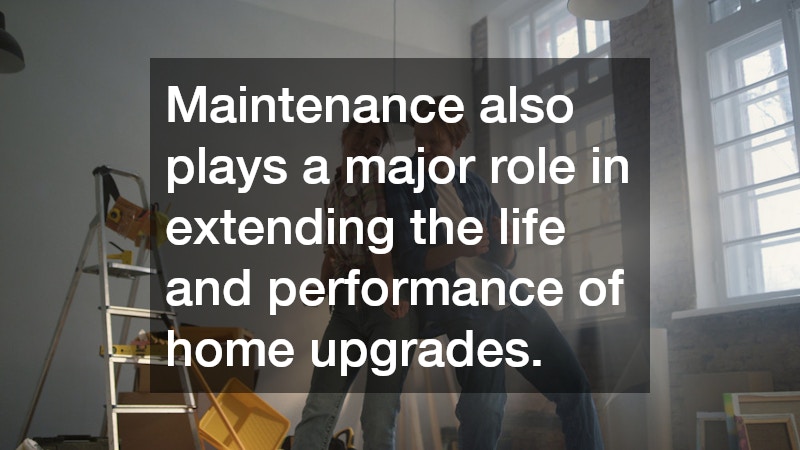Modern home upgrades are no longer limited to surface-level improvements. Today’s homeowners are increasingly focused on enhancements that promote comfort, sustainability, cost savings, and long-term livability. Whether the goal is to build a more functional layout, improve energy performance, or create a space that reflects personal style, thoughtful updates can dramatically improve a property’s overall appeal.
The key is identifying upgrades that provide true value—both immediately and over time. This requires a balanced approach that blends design trends, practical functionality, and professional expertise. The right improvements not only elevate everyday living but also boost resale potential and minimize ongoing maintenance needs.
This guide explores a wide range of modern home upgrades that help homeowners achieve a higher standard of comfort, efficiency, and style while maintaining a forward-looking approach to design and performance.

Partnering With the Right Professionals for High-Quality Results
When undertaking significant home upgrades, choosing qualified professionals is essential. Many updates require expertise far beyond basic handyman work, especially when structural changes, additions, or specialty installations are involved. Partnering with experienced professionals ensures that every improvement is both safe and visually cohesive.
Choosing Experts Who Can Bring a Vision to Life
A reputable home construction company can provide broad support, from initial planning to structural execution. These companies typically employ teams that include carpenters, designers, and project managers who coordinate all aspects of the renovation.
Key qualities to look for include:
-
Proper licensing and insurance
-
Transparent estimates and timelines
-
Portfolios showcasing a range of completed projects
-
Positive reviews and strong community reputation
Working with specialists also helps align your upgrades with local codes and safety requirements. Regulations can vary significantly across regions, and failing to meet them may result in costly fixes or project delays.

Tailoring Projects to Your Home’s Unique Needs
Owners of custom homes often require more specialized knowledge, particularly when integrating new systems or designing updates that complement existing architectural styles. Custom properties may include unique framing, high-end materials, or specialized features that require more precise craftsmanship.
Professionals experienced in custom construction understand how to blend new improvements seamlessly with original elements, ensuring the home retains its cohesive appearance and structural integrity.
Integrating Technology for Smarter and More Efficient Living
As technology continues to advance, integrating intelligent systems into the home has become a priority for many homeowners. Thoughtfully designed tech upgrades can improve convenience, reduce energy waste, and increase household security.
Enhancing Comfort Through Connected Devices
Smart home automation enables homeowners to control lighting, temperature, entertainment systems, and appliances with the touch of a button or the sound of a voice. With integrated platforms, various systems communicate seamlessly and adjust automatically based on user preferences.
Popular automated upgrades include:
-
Climate control systems that learn usage habits
-
Smart lighting with dimmers and motion sensors
-
App-controlled blinds and window treatments
-
Multi-room audio networks
-
Automated leak detection and water shutoff systems
These features not only enhance comfort but also help reduce unnecessary power consumption.
Improving Security and Energy Use
Smart security systems offer real-time alerts, remote monitoring, and automated locks. Surveillance cameras, door sensors, and motion detectors provide an additional layer of protection for both the interior and exterior of the home.
Energy monitoring tools also track electricity usage, helping homeowners identify patterns and make adjustments to improve efficiency. Over time, these features can significantly reduce utility bills and environmental impact.
Upgrading Kitchens for Functionality and Timeless Style
The kitchen remains one of the most valuable areas of the home, making it a focal point for upgrades. Whether homeowners want to enhance storage, improve workflow, or create a more inviting atmosphere, even small changes can have a major impact.
Improving Storage and Flow With Better Cabinetry
High-quality kitchen cabinets are the foundation of a functional and stylish kitchen. Modern cabinetry options include soft-close drawers, built-in organizers, pull-out shelving, and tall pantry units that maximize storage capacity.
Considerations when upgrading cabinets:
-
Choose materials that resist warping and moisture.
-
Match finishes and styles to other architectural elements.
-
Upgrade hardware to match current design trends.
-
Add under-cabinet lighting for enhanced visibility and ambiance.
Efficient cabinetry ensures that the kitchen remains uncluttered and user-friendly, making daily tasks easier and more enjoyable.
Ensuring Appliances Perform at Their Best
Before investing in new appliances, it’s important to evaluate whether refrigerator repair or minor servicing can extend their lifespan. Many common issues—such as temperature inconsistencies, noisy motors, or ice maker malfunctions—can be repaired at a fraction of the cost of replacement.
Extending appliance life yields benefits like:
-
Lower upfront expenses
-
Reduced landfill waste
-
Consistent performance without disrupting the kitchen’s design
Regular maintenance also supports energy efficiency and helps avoid sudden breakdowns.
Enhancing Indoor Aesthetics With Strategic Material and Fixture Updates
Interior spaces gain a polished, updated look through thoughtful material and fixture choices. Bathrooms, in particular, benefit from durable and visually appealing upgrades that enhance comfort and style.
Improving Bathroom Comfort Through Modern Design Choices
Replacing old curtains with stylish shower doors can instantly transform a bathroom. Frameless glass designs make the space feel larger and brighter, while textured or frosted options add privacy without sacrificing natural light.
Benefits of high-quality shower enclosures include:
-
Improved hygiene and easier cleaning
-
Enhanced durability compared to fabric or plastic curtains
-
Better moisture control to prevent mold and mildew
-
A refined, high-end look
Creating a Cohesive, Updated Look Throughout the Home
Material and fixture upgrades should extend beyond the bathroom. Updating flooring, wall treatments, lighting, and hardware ensures consistency across all rooms. Even small touches—like replacing outdated doorknobs or light switches—can make a home feel more modern and polished.
Improving Energy Efficiency With Smart Exterior Updates
Energy-efficient exterior upgrades play a significant role in creating a comfortable and eco-friendly home. High-performance installations can reduce utility costs, enhance airflow, and improve indoor climate control.
Boosting Insulation and Reducing Energy Costs
Modern window replacements often feature double or triple-pane glass, insulated frames, and low-emissivity coatings designed to minimize heat transfer. These advancements help keep homes cooler in summer and warmer in winter.
Additional benefits include:
-
Reduced outside noise
-
Increased property value
-
Improved UV protection for flooring and furniture
-
Better reliability and reduced air infiltration
Enhancing Natural Light While Maintaining Privacy
The right window upgrades also enhance lighting and ambiance. Homeowners can choose from various tints, grids, and glass finishes that allow natural light in without compromising privacy. Proper placement ensures optimal daylight distribution throughout the home.
Revitalizing Outdoor Living Spaces for Relaxation and Entertainment
Outdoor areas are becoming extensions of indoor living space. Thoughtful upgrades allow homeowners to create functional, comfortable environments ideal for gatherings, relaxation, and recreation.
Designing a Functional, Low-Maintenance Outdoor Area
Working with an experienced deck company ensures that outdoor structures are built safely, efficiently, and in compliance with local codes. Professional builders help design layouts that balance comfort, aesthetics, and practicality.
Popular outdoor features include:
-
Multi-level decking
-
Built-in seating
-
Outdoor kitchens
-
Fire pits and heating elements
-
Covered patios for year-round use

Choosing Durable Materials for Year-Round Enjoyment
Material selection plays a crucial role in longevity. Options like composite decking resist fading, warping, and cracking, while treated wood offers traditional charm with proper maintenance. Waterproofing, sealing, and UV protection further extend the life of exterior installations.
Maximizing Property Value With Strategic Surface Enhancements
Surface updates improve both safety and aesthetics and are especially important for high-use outdoor areas.
Refreshing High-Wear Areas for Better Aesthetics
Applying pool epoxy coating can transform a worn pool surface into a smooth, durable, and visually appealing feature. The coating seals cracks, prevents leaks, and provides a slip-resistant finish that enhances safety.
Additional benefits include:
-
Protection from chemical damage
-
Resistance to algae buildup
-
Long-term color retention
-
Improved water clarity and cleanliness
Updating Hardscapes and Outdoor Features
Similar surface improvements can be applied to patios, driveways, and walkways. Concrete staining, sealing, and resurfacing extend the life of these surfaces and reduce maintenance needs.
Maintaining Long-Term Cleanliness and Care With Professional Support
After investing in substantial home upgrades, maintaining cleanliness becomes essential for preserving value.
Keeping a Home Looking New After Major Upgrades
A professional janitorial company can help homeowners keep interiors spotless, especially during or after renovation projects. These services ensure that dust, debris, and residue are thoroughly removed, protecting surfaces and improving indoor air quality.
Cleaning services may include:
-
Deep cleaning of floors and carpets
-
Window washing and detailing
-
Surface sanitation
-
Post-renovation cleanup
Protecting Investments Through Preventive Maintenance
Regular maintenance prevents damage and prolongs the lifespan of upgrades. Establishing a seasonal cleaning schedule ensures that surfaces, fixtures, and systems remain in optimal condition year-round.
Planning, Budgeting, and Prioritizing Home Upgrades Wisely
Large-scale home improvements require careful planning and disciplined budgeting. Without a clear strategy, costs can quickly escalate and timelines may extend longer than expected.
Determining Which Projects Offer the Best Value
Some upgrades deliver more significant returns than others. High-impact projects may include kitchen enhancements, bathroom updates, exterior improvements, and energy-efficient installations. Prioritizing these upgrades ensures a strong balance between personal comfort and financial return.
Creating a Roadmap for Future Improvements
Not all updates must be completed at once. Many homeowners benefit from a phased approach that spreads the investment over time. This strategy reduces financial strain and allows for adjustments based on new needs or market trends.
Expanding on Strategic Planning for Major Renovations
When approaching large-scale home improvements, one of the most effective steps is conducting a thorough assessment of the property’s current condition. This includes identifying structural issues, outdated systems, or areas that are no longer meeting your needs. A detailed evaluation can help you determine where to begin and how to allocate your budget wisely. Homeowners often overlook hidden costs like outdated electrical panels, insufficient insulation, or aging plumbing lines, all of which can impact renovation timelines and expenses if not addressed proactively.
Another essential factor in planning is defining clear goals for each project. Are you renovating to increase resale value, improve comfort, expand functionality, or enhance energy efficiency? Your goals directly influence decisions about materials, design, and scope. Establishing these priorities early helps prevent impulsive upgrades or unnecessary changes that may disrupt the budget.
Building a Realistic Budget and Timeline
Setting a realistic budget involves more than accounting for materials and labor. Successful planning includes allocating funds for unexpected expenses, which commonly arise during renovations. Industry professionals recommend setting aside ten to twenty percent of the total project cost as a contingency buffer. This safety net prevents delays or compromises when surprises occur behind walls or beneath flooring.
Timelines should also be carefully considered. While it is tempting to fast-track improvements, rushing often results in costly errors. Homeowners benefit from collaborating with qualified professionals who can provide accurate estimates and help sequence projects logically. For example, structural or systems upgrades should occur before cosmetic enhancements to avoid undoing completed work.
Leveraging Professional Insight for Better Outcomes
Working with experienced contractors, designers, or architects can streamline even the most complex renovation plans. These professionals can identify potential challenges early, provide innovative solutions, and guide material selections that align with your goals and budget. Their expertise often leads to higher-quality results and fewer costly revisions.
Maintaining Flexibility Over Time
Finally, large-scale home improvement planning should remain flexible. As trends evolve, technology advances, and household needs shift, your roadmap should be adaptable. A long-term plan can incorporate future projects—such as energy-efficient upgrades, layout reconfigurations, or outdoor enhancements—without overwhelming your current schedule or financial resources.
Creating a home that blends comfort, efficiency, and style requires thoughtful planning, strategic investments, and expert guidance. Modern upgrades allow homeowners to enhance both day-to-day living and long-term property value. Whether focusing on aesthetics, structural improvements, or energy performance, each decision plays an important role in shaping a more enjoyable and functional environment. Through a combination of quality craftsmanship, smart technology, and regular maintenance, every home can evolve into a space that supports a more convenient, sustainable, and fulfilling lifestyle.
Expanding on this idea, it is also essential for homeowners to regularly reassess their needs as life changes. A home that worked perfectly five years ago may no longer serve the same purpose today, especially as families grow, work-from-home routines become more common, or accessibility needs shift. Continually evaluating how each space is used helps identify new opportunities for improvement and ensures that investments continue to provide lasting value.
Equally important is staying informed about emerging trends and technologies. Today’s innovations in building materials, automation, and energy efficiency can dramatically influence comfort, safety, and long-term cost savings. Homeowners who stay proactive in learning about these advancements are better equipped to make upgrades that not only improve day-to-day living but also future-proof their property.
Maintenance also plays a major role in extending the life and performance of home upgrades. Even the most beautifully designed improvements can lose value without consistent care, inspections, and timely repairs. Setting a regular maintenance schedule allows homeowners to protect their investments and ensure that every improvement continues to function at its best.
Ultimately, a thoughtfully upgraded home becomes more than a place to live—it becomes a personal retreat designed to enhance well-being, increase efficiency, and support the lifestyle you envision for years to come.

